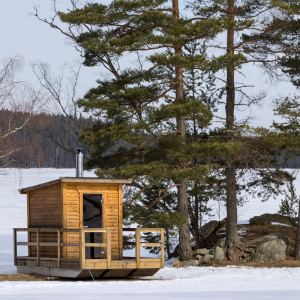 Winter “frostrates” me. I have to work at not letting it get me down. I was thinking recently that this coming winter might be even more challenging with the pandemic and all basically putting a chill, so to speak, on my usual ways to keep my spirits up. My Finnish grandmother, who embodied sisu, came to mind and I said to myself “C’mon Laurie, tap into some of that sisu that Grammy Saimi passed on to you!” Then, lo and behold, I was perusing Overdrive and The Finnish Way: Finding Courage, Wellness and Happiness Through the Power of Sisu (by Katja Pantzar) popped up as a recommendation. Seems Google really is listening. So here is what I learned about sisu and the Scandinavian wisdom of hygge and lagom in my exploration of Nordic winter ways. This winter I’m determined to chillax!
Winter “frostrates” me. I have to work at not letting it get me down. I was thinking recently that this coming winter might be even more challenging with the pandemic and all basically putting a chill, so to speak, on my usual ways to keep my spirits up. My Finnish grandmother, who embodied sisu, came to mind and I said to myself “C’mon Laurie, tap into some of that sisu that Grammy Saimi passed on to you!” Then, lo and behold, I was perusing Overdrive and The Finnish Way: Finding Courage, Wellness and Happiness Through the Power of Sisu (by Katja Pantzar) popped up as a recommendation. Seems Google really is listening. So here is what I learned about sisu and the Scandinavian wisdom of hygge and lagom in my exploration of Nordic winter ways. This winter I’m determined to chillax!
Serious winter cred
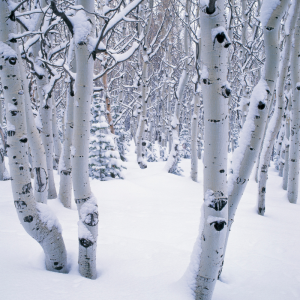 First of all, the Finns (and Scandinavians too) have some serious cred when it comes to winter. Think we here in Toronto have it bad? Ha! In the northernmost corner of Finland, the polar night (where the sun does not rise above the horizon at all), lasts 51 days. In southern Finland, the shortest day is about 6 hours long. According to visitfinland.com, “Depending on location, winter in Finland begins in November and can last up to five months, with temperatures ranging from a balmy zero to a lung-freezing minus 35.” I bet that attracts the winter tourists in droves! And there is permanent snow cover from about two weeks after winter begins. Yet, despite this, Helsinki, Finland snagged the top spot of 186 cities ranked in the World Happiness Report 2020 Global Ranking of Cities.
First of all, the Finns (and Scandinavians too) have some serious cred when it comes to winter. Think we here in Toronto have it bad? Ha! In the northernmost corner of Finland, the polar night (where the sun does not rise above the horizon at all), lasts 51 days. In southern Finland, the shortest day is about 6 hours long. According to visitfinland.com, “Depending on location, winter in Finland begins in November and can last up to five months, with temperatures ranging from a balmy zero to a lung-freezing minus 35.” I bet that attracts the winter tourists in droves! And there is permanent snow cover from about two weeks after winter begins. Yet, despite this, Helsinki, Finland snagged the top spot of 186 cities ranked in the World Happiness Report 2020 Global Ranking of Cities.
Sisu
So the Finns obviously don’t let their winter get them down. Finns embrace it. In fact, so many of them enjoy swimming outdoors in winter that there are waiting lists for winter swimming clubs. Now that is sisu! So, how does one define this special brand of Finnish resilience? The book explores many interpretations, but these were my favourites:
- “Sisu is like a metaphorical shot in the arm that allows the individual to do what’s impossible.” – Jean Sibelius (1865-1957), one of Finland’s best known composers.
- “The clue is in the word sisus, which is literally the interior, or inside of a thing or being. Then it hit me that sisu is like the somatic embodiment of mental toughness. What we attribute to the mind – our strength and our ability to keep going no matter what – is also reflected in our bodies….We always talk about the brain, but it’s also the gut.” – Sisu expert Emilia Lahti.
And, also from Emilia Lahti, “Sisu gives rise to what I call an action mindset; a courageous attitude which contributes to how we approach challenges. Sisu is a way of life to actively transform the challenges that come our way into opportunities, and build a bridge toward our best possible future self.
Sounds good to me! So how do we bring the spirit of sisu into our daily lives?
Winter swimming
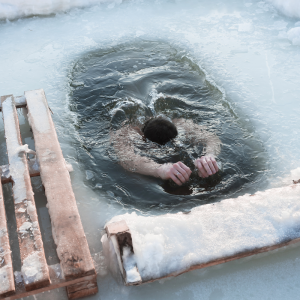 Let’s go back to that winter swimming I mentioned earlier. “Whaaa?”, you are probably thinking, “How does immersing yourself in freezing cold water help?!” I will let Professor Hannu Rintamäki, one of Finland’s top cold experts, answer that one. “A dip of about thirty seconds to one minute in water that’s on average about 4 degrees Celsius during the winter months causes what’s known as a ‘hormone storm’, as many of the so-called happy hormones are pushed into action.”
Let’s go back to that winter swimming I mentioned earlier. “Whaaa?”, you are probably thinking, “How does immersing yourself in freezing cold water help?!” I will let Professor Hannu Rintamäki, one of Finland’s top cold experts, answer that one. “A dip of about thirty seconds to one minute in water that’s on average about 4 degrees Celsius during the winter months causes what’s known as a ‘hormone storm’, as many of the so-called happy hormones are pushed into action.”
These are:
- endorphins – the body’s natural painkillers
- serotonin – which helps maintain mood balance
- dopamine – which helps control the brain’s reward and pleasure centres and also helps regulate movement and emotional response
- oxytocin – the “love hormone”
A pretty potent hormone cocktail for feeling better I’d say. Additionally, winter swimming stimulates nourishing blood circulation, burns calories and supports the immune system. Katja reported that it helped her tap into a deep reserve of strength and resilience she didn’t know she possessed. Not bad for a 30 second to one minute investment. You need to work up to it though and it isn’t recommended for anyone with cardiovascular conditions.
The Swedes also have a version of this, called the morgondopp, or morning dip, done first thing in the morning. Yes, even before coffee! Admittedly more popular between May and September, there are hardy folk that do this all year round.
Without easy access to open water here, I’m starting with cold showers. So far I have managed 15 seconds. One day at a time. Of course, all this cold therapy would be easier with that pillar of Finnish culture, a sauna, to hop into before or after (or both)!
Sauna (click here for a fun article about the heated debate on how to pronounce it…)
“Sisu, sauna, and Sibelius” is Finland’s unofficial motto, according to Katja. She says there are an estimated 3.3 million saunas for the Finnish population of 5.5 million. I grew up spending summers at my grandparents’ place on a lake in the Ottawa Valley which, thanks to my grandmother, has a wood-burning sauna. It remains my favourite past-time there. One Finnish proverb translates to “If sauna, liquor, or tar doesn’t help, the disease is probably fatal.” [The tar refers to birch tar, which is used to improve everything from digestion to skin problems.]
I can personally vouch for many of these benefits listed by The Finnish Sauna Society:
- soothing and relaxing muscles
- relieving tension and fatigue
- effecting better sleep
- maintaining clear and healthy skin
Less overt but found in studies, saunas may improve circulation, lower blood pressure and increase resistance to illness. I’d be happy to have any sauna right now, but steam saunas (as opposed to dry saunas) are my favourite. Even the Finnish word for the hot steam that comes from pouring water on the rocks, löyly, sounds joyful! On a more spiritual level, it means the entire feeling of the heat as it envelopes you, as well as the steam that fills the room. It’s a wonderfully warming hug!
 Unfortunately, with gyms currently closed, gaining access to a sauna right now may be challenging. But you could try going outside in your bathing suit for as long as you can stand the chill and then hop into a hot bath. And then repeat. At the very least, you will have your neighbours wondering if you’ve gone a tad mad. If you could find yourself a flesh-coloured swimsuit, they’d think you’ve gone completely starkers! This photo is from March of this year, when we went to the family cottage in the Ottawa Valley for some stress-relieving sauna sessions just as lockdown commenced and the world changed.
Unfortunately, with gyms currently closed, gaining access to a sauna right now may be challenging. But you could try going outside in your bathing suit for as long as you can stand the chill and then hop into a hot bath. And then repeat. At the very least, you will have your neighbours wondering if you’ve gone a tad mad. If you could find yourself a flesh-coloured swimsuit, they’d think you’ve gone completely starkers! This photo is from March of this year, when we went to the family cottage in the Ottawa Valley for some stress-relieving sauna sessions just as lockdown commenced and the world changed.
Hyötyliikunta (incidental exercise)
North Americans tend to be fairly sedentary and then binge-exercise an hour or so a day to get their exercise quota in (one author on women’s health commented that North American women have two speeds…sit or “spin”). This is not ideal. More optimal is to take a consistent, balanced approach and try to fit in simple, no-special-exercise-gear-required, functional movement throughout the day along with your fitness training.
And the Finns believe in the concept of lääke, or movement as medicine. Not only do they believe that movement helps prevent chronic conditions, it also tends to be a first line of therapy in managing certain conditions. Such as when aches and pains set in or your mood plummets. If you have a headache, or stiff muscles or joints, go for a walk outside in the fresh air and/or perform some light stretches to see if that brings relief before popping a pain-killer. And the hot-cold therapies of sauna and winter swimming are tremendously helpful for this as well. And while I admit there are many days when I don’t feel up to getting outside for exercise, there are probably zero days where I wasn’t glad afterward that I did.
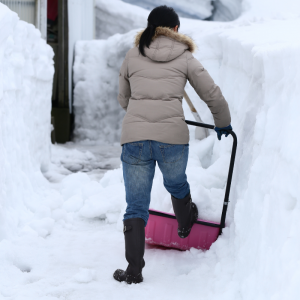 So how can we hike our levels of hyötyliikunta? A first step is to stop actively pursuing ways to avoid movement and/or outsourcing tasks that we might gain some exercise by doing ourselves.
So how can we hike our levels of hyötyliikunta? A first step is to stop actively pursuing ways to avoid movement and/or outsourcing tasks that we might gain some exercise by doing ourselves.
- take the stairs not the escalator or elevator
- walk or cycle (many Finns ski!) to the local shops (or park further away if it is too far to go under personal power)
- clean your house yourself
- mow your own lawn
- rake your leaves yourself
- shovel your snow yourself
- walk your pets yourself
- do your own gardening
- cook your own meals (there is a surprising amount of movement involved in getting everything out of the fridge and prepped and moving pots and pans about etc)
- take a walk around the block first thing in the morning and as breaks throughout the work day (a little exercise and fresh air in the afternoon will energize you far better than coffee and will help, not hinder, your sleep)
- take a meandering stroll after dinner to help with digestion and sleep
- this is obviously not a Nordic tradition, but I personally like to do yoga each morning…sometimes it is a full practice but often it is just 5 or 10 minutes of yoga poses to get the blood flowing; it is also a nice way to wind down at night (here are simple sequences for Morning Wake Up and Evening Wind Down from Calm Body)
- if you are fortunate enough to live near a lake, try the morgondopp!
Use any opportunity for movement, even if all you can manage to do at that moment is some arm circles. Any movement is better than no movement. And the best part of lääke, or movement as medicine, is that the side effects are all positive!
The Nordic diet
I like the Nordic approach as it is quite sensible, sustainable and straightforward. Like sisu, it is also a mindset. It is less about decreasing the bad and more about focusing on the good. And it isn’t about deprivation. After all, you need a decent amount of fuel to handle all that winter swimming, sauna-ing and hyötyliikunta. If you eat the right foods, you can eat as much as you need to feel satisfied and there is no need to count calories. So what are these foods?
- A hearty breakfast, lunch and dinner, eaten in a relaxed manner
- seasonal, whole, unprocessed, foods – many Finns enjoy gardening and grow some of their own foods in home, community or cottage gardens. Pick-your-own and farmers’ markets are very popular as well.
- Plenty of colourful vegetables and fruits (half your plate).
- Berries – full of fibre and powerful antioxidants…and delicious! Don’t shy away from frozen berries in
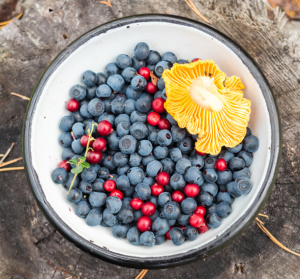 the winter, they are tastier and more nutritious than those shipped from afar.
the winter, they are tastier and more nutritious than those shipped from afar. - Nuts – sprinkled on yogurt, muesli, porridge, veggies or as a snack. Dry roasted and unsalted are best.
- Wild mushrooms – rich in fibre and B-complex vitamins, Finns often forage these (as well as nuts, berries and wild herbs) so they get some good exercise and connection to nature in as well.
- Oily fish (think salmon, herring, char) frequently, poultry and game meats
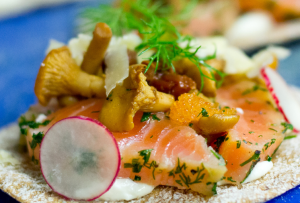 moderately and red meat rarely.
moderately and red meat rarely. - Herbs – easy to grow at home, even using an indoor window-box in the winter; a rosemary plant will make your house smell wonderful too!
- Rye bread – rye was cultivated in Finland and has a high fibre content and triggers less of an insulin response than wheat flour, so it helps keep blood sugar steady
- Clean, pure water and lots of it.
- Homemade sweet treats, on occasion. This recipe for Pulla, a cardamom coffeebread, is traditional at
 Christmas but I would happily eat it any time (simply with slivered almonds on top). And if you work the dough by hand, you will get some of that “much-kneaded” incidental exercise. The linked recipe shows it as a wreath, but you can also simply make it into braids, like I did one Christmas (see picture).
Christmas but I would happily eat it any time (simply with slivered almonds on top). And if you work the dough by hand, you will get some of that “much-kneaded” incidental exercise. The linked recipe shows it as a wreath, but you can also simply make it into braids, like I did one Christmas (see picture).
Scandi winter wisdom
But there is more to the approach Nordic countries take to life beyond sisu. Hygge and lagom are also welcome in this lexicon.
- Hygge: visitdenmark.com says “hygge means creating a warm atmosphere and enjoying the good things in life with good people. The warm glow of candlelight is hygge. Cosying up with a loved one for a movie – that’s hygge, too. And there’s nothing more hygge than sitting around with friends and family, discussing the big and small things in life.” So pull out those candles. Add cosy throws or blankets to your couch. Don your warmest, fuzziest slippers, woolliest sweaters and slouchiest pants. Make mugs of soothing tea, coffee, lattes (try these winter latte mixes) or toddies. And delve into a good book or film or chat with your loved ones (even if it is by phone). This word is the source of the English word “hug”. So embrace yourself and be kind and comforting.
- Lagom: this Swedish word roughly translates to “not too little, not too much” or “just right”. The idea is to live a balanced life, free of fuss. And to slow down a little and be mindful of your surroundings. Take breaks throughout the day. Keep your “to do” list realistic. Prioritize what matters to you. Take time for yourself.
Don’t over-sisu it
While sisu is an action mind-set of resilience and turning challenges into opportunities, you have to be mindful not to over-sisu it, as type A personalities may be prone to do. The Swedish principle of lagom applies here too. Don’t be too stubborn or push yourself too hard. Know when and, perhaps more importantly, that it is alright to ask for help. And don’t forget that a big part of hygge is the connection with other people. In fact, sisu, hygge and lagom taken together illustrate lagom well: not too much, not too little, but just right.
Niin metsä vastaa, kuin sinne huudetaan
Lastly, this Finnish proverb is useful to keep in mind during these trying times when it is easy to become impatient and even angry. Niin metsä vastaa kuin sinne huudetaan roughly translates to “the forest answers in the same way one shouts at it”. It refers to an echo but is commonly thought to mean “what goes around comes around”. Or that the way you treat people will reflect in their words or actions toward you. So be kind and compassionate to others right now as well as to yourself.
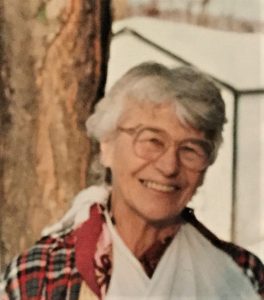 There are other interpretations, however. I was thinking it might also be interpreted as “ask and you shall receive” or “the Universe provides”. For example, I was thinking about how to channel the sisu of my grandmother (at left) and the Universe provided me with Katja Pantzar’s wonderful book on how to integrate the principles of sisu into my life to help me weather this winter. Now if only the Universe would provide me with a sauna… Any chance you might put in a celestial word, Grammy Saimi? 😉
There are other interpretations, however. I was thinking it might also be interpreted as “ask and you shall receive” or “the Universe provides”. For example, I was thinking about how to channel the sisu of my grandmother (at left) and the Universe provided me with Katja Pantzar’s wonderful book on how to integrate the principles of sisu into my life to help me weather this winter. Now if only the Universe would provide me with a sauna… Any chance you might put in a celestial word, Grammy Saimi? 😉